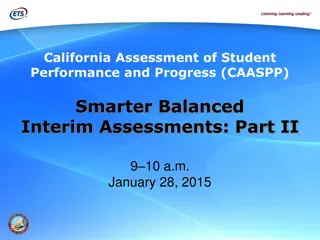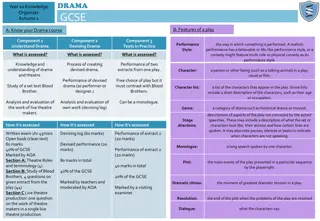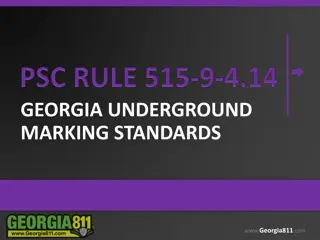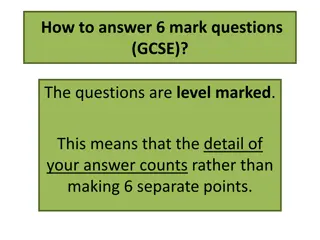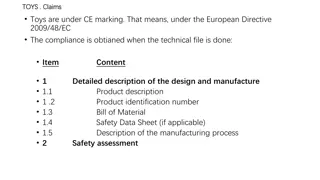Exploring the Case for Double Marking in GCSE and A-Level Assessments
Delve into the concept of double marking, its significance in educational evaluations like GCSE and A-Level assessments, various methodologies like adjudication, and a hypothetical worked example to illustrate its impact on marks. The study evaluates the proximity to definitive marks under single marking, double marking, and double marking with adjudication, providing insights for better assessment practices in academic settings.
Download Presentation

Please find below an Image/Link to download the presentation.
The content on the website is provided AS IS for your information and personal use only. It may not be sold, licensed, or shared on other websites without obtaining consent from the author. Download presentation by click this link. If you encounter any issues during the download, it is possible that the publisher has removed the file from their server.
E N D
Presentation Transcript
Double marking? is there a case for GCSE and A level marking? Beth Black and Stephen Rhead
Outline of presentation Double marking intro what is double marking? Why double mark? Research design Hypothetical worked example Data from study Double marking Double marking with adjudication Component level double marking Caveats Operational considerations Conclusions 2
double marking version 1 9 9 8 Marked independently by two examiners they are not aware of the other s mark Take the average (and round up) Script/item 3
double marking version 2 (helps when marks are far apart adjudication ) 9 8 9 6 Marked independently by two examiners i.e. not aware of the other s mark Item is Take the average of the two closest marks and round up. distributed to a third marker who marks independently Script/item 4
Study Simulate double marking Use seeding data from live marking meets assumptions of independent marks Compare the proximity to the definitive mark for: single marking versus double marking versus double marking with adjudication 5
A hypothetical worked example Seed item A Single mark = 7 Seed item A Definitive mark = 9 Seed item A Double mark = 7.5 Seed item A Double mark = 8.5 Seed item A Single mark = 8 Seed item A Double mark = 8 Seed item A Double mark = 9 Seed item A Double mark = 9 Seed item A Single mark = 9 Seed item A Double mark = 8 Seed item A Single mark = 9 Seed item A Double mark = 8.5 Seed item A Double mark = 9.5 Seed item A Double mark = 8.5 Seed item A Double mark = 9.5 Seed item A Single mark = 10 6
A hypothetical worked example rounded Seed item A Single mark = 7 Seed item A Definitive mark = 9 Seed item A Double mark = 8 Seed item A Double mark = 9 Seed item A Single mark = 8 Seed item A Double mark = 8 Seed item A Double mark = 9 Seed item A Double mark = 9 Seed item A Single mark = 9 Seed item A Double mark = 8 Seed item A Single mark = 9 Seed item A Double mark = 9 Seed item A Double mark = 10 Seed item A Double mark = 9 Seed item A Double mark = 10 Seed item A Single mark = 10 7
A hypothetical worked example Single marking Single v double marking 8
A hypothetical worked example Proximity to the definitive mark 0% +20% +10% Cumulative percentage 9
A hypothetical worked example May sometimes be the case that single is better than double . Proximity to the definitive mark 0% +20% -5% +10% -10% 10
Why might double marking not always be better? First marker Good Lenient Harsh Inconsistent Second marker Good lenient harsh ? Good lenient lenient good ? Lenient harsh good harsh ? Harsh ? ? ? ? Inconsistent Ref: Elizabeth Gray 11
Advantages of research design Very large data set Live scripts marked under live marking conditions Examiners standardised In-session high stakes marking Normal use of marking software Can look at different subjects, items with different tariffs etc. 12
Data 958 k marking events (2015) 1 million items For each event match all possible combinations of examiners 30 million pairs of marks 13
double marking 9 9 8 Marked independently by two examiners they are not aware of the other s mark Take the average (and round up) Script/item 15
Proximity to definitive mark short answer questions (1 to 5 mark items) in a range of subjects Virtually no benefit Probably because the marking on short answer questions tends to be fairly consistent 1 mark 2 marks 3 marks 4 marks 5 marks 16
Proximity to definitive mark longer response items (6 to 40 mark items) 6 mark items 12 mark items 16 mark items 20 mark items 30 mark items 40 mark items 17
Single versus double probability differences Subject differences? A look at 16 mark items Proximity to the definitive mark Business English Geography History Events = 819 Pairs = 6482 Events = 6,080 Pairs = 484,118 0 1.5 4.4 0.7 -1.0 1 6.9 8.8 5.0 1.6 2 7.6 5.4 7.6 3.8 Business English 3 4.8 1.9 5.6 3.5 4 3.0 0.5 3.7 2.8 5 1.1 0 1.6 1.6 Events = 877 Pairs = 25,368 Events = 5,514 Pairs = 143,079 6 0.5 0 1.0 0.6 7 0.2 0 0.9 0.5 8 0 0 0.1 0.1 History Geography 9 0 0 0 0 10 0 0 0 0 18
double marking version 2 (helps when marks are far apart adjudication ) 9 8 9 6 Marked independently by two examiners i.e. not aware of the other s mark Item is Take the average of the two closest marks and round up. distributed to a third marker who marks independently Script/item 20
Double marking with adjudication - proximity to definitive mark - 16 mark items Single versus double+adjudication probability differences Absolute mark difference Business English Geography History 0 4.1 -2.04 2.9 1.9 1 9.4 1.0 12.3 9.6 2 16.5 7.7 20.2 17.9 Business English 3 8.1 2.0 9.6 9.6 4 4.1 0.5 4.6 5.5 5 2.2 0 1.4 3.1 6 2.2 0 0.8 1.3 7 1.0 0 0.1 0.8 8 0.4 0 0 0.4 Geography History 9 0 0 0 0.2 10 0 0 0 0.1 21
Impact on receiving definitive grade at component level Geography double marking Unit difference (%) in probability of candidates receiving the definitive grade Double marking Double marking with adjudication 2.2 3.9 9.7 3.2 4.4 3.9 4.55 #1 #2 #3 #4 #5 #6 5.6 4.5 8.1 2.2 4.2 5.1 4.95 Average 23
Impact on receiving definitive grade at component level English Literature double marking Unit difference (%) in probability of candidates receiving the definitive grade Double marking Double marking with adjudication 7.0 4.7 -2.9 5.7 5.3 4.3 6.4 7.0 4.7 #1 #2 #3 #4 #5 #6 #7 #8 4.3 1.7 -2.3 0 0.3 -2.5 4.9 3.9 1.3 Average 24
Why might double marking not always be better? First marker Good Lenient Harsh Inconsistent Second marker Good lenient harsh ? Good lenient lenient good ? Lenient harsh good harsh ? Harsh ? ? ? ? Inconsistent Ref: Elizabeth Gray 25
Caveats We haven t yet been able to model at qualification level There are other models of adjudication which we have not modelled e.g. Average of three marks Adjudication through discussion Adjudicating marker is a senior marker Cannot simulate washback/psychological effects of being a double marker 26
Other things to consider By the way, some of the improvements to accuracy will involve marks going up and some will involve marks going down. Operational implications Double marking would require 2.5 x current number of markers Extending pool of markers might dilute the quality of markers Any positive effects of double marking in the simulation may be reduced/destroyed? Washback effects from being a double marker??? e.g. less high stakes? avoidance of mark extremes? May be motivated to try hard to ensure mark is as accurate as possible so that likely to be close to second marker 27
A balancing act http://www.clker.com/cliparts/P/l/w/0/i/E/brown-rope-sack-md.png http://www.clker.com/cliparts/P/l/w/0/i/E/brown-rope-sack-md.png Costs Potential benefits in marking Positive washback on marking behaviours? Dilution of marker quality? Negative washback on marking behaviours? 28 28
Conclusions Not a uniformly compelling case for using double marking though there may be a case in some particular areas (and what does other research show?) In each case, the question will be: is this the optimum use of resource to improve quality of marking? Are there other, more cost effective ways? [of course, we want improvement in marking is this the best way?] Ofqual rules do not prevent boards from double marking. 29














